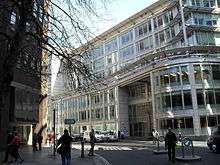Fetter Lane
| Fetter Lane | |
 Fetter Lane |
|
| Sui generis | City of London |
|---|---|
| Administrative area | Greater London |
| Region | London |
| Country | England |
| Sovereign state | United Kingdom |
| Post town | LONDON |
| Postcode district | EC4A |
| Dialling code | 020 |
| Police | City of London |
| Fire | London |
| Ambulance | London |
| EU Parliament | London |
| UK Parliament | Cities of London and Westminster |
| London Assembly | City and East |
Coordinates: 51°30′54″N 0°06′35″W / 51.5150°N 0.1096°W

Fetter Lane is a street in the ward of Farringdon Without in the City of London. It forms part of the A4 road and runs between Fleet Street at its southern end and New Fetter Lane, which continues north towards Holborn Circus.
History
The earliest mention of the street is "Faitereslane" in 1312.[1] The name occurs with several spellings until it settles around 1612. There is no complete agreement about the origin of the name, but theories include: "Feuterer-lane" (feuterer = a keeper of dogs) and Fewtor/Faitour (a worthless fellow). At the southern end, towards Fleet Street, is situated Clifford's Inn, established in 1345. Towards the northern end, near Holborn, is Barnard's Inn. They were both Inns of Chancery. The official address of the old Public Record Office (1856–1997) was on Chancery Lane, but the back of this building dominates the southern stretch of Fetter Lane. It is now the Maughan Library belonging to King's College London.
On Fleet Street is St. Dunstan-in-the-West, and next to it, at 133–137 Fetter Lane, is St. Dunstan's House. In Victorian times the publishing house Sampson Low was located at St. Dunstan's House. Two plaster reliefs (1886) by Walter Crane were salvaged from the building when it was destroyed in 1905. They now stand next-door in the King's College library.[2] The site then became the main London warehouse of the Cambridge University Press. It is now the Technology and Construction Court hearing litigation related to science and engineering. The Admiralty Court is also at St. Dunstan's House.
In the 1590s there was a gibbet at the junction of Fleet Street and Fetter Lane. Christopher Bales was among those hanged there. It is sometimes said that John Dryden lived at No. 16, but there is no evidence for this. In 1604, John Dowland published "Lachrimae". The preface states "to be solde at the authors House in Fetter-lane neare Fleet-streete".[3] In 1651 Thomas Hobbes lived in Fetter Lane. In the opening paragraphs of Gulliver's Travels the central character states that he lived briefly at Fetter Lane. From 1660 to 1680 Thomas Goodwin preached at the Fetter Lane Independent Church.[4]

At No. 33, the Moravian Chapel (Fetter Lane Society) was founded in 1738. The Trust Society for the Furtherence of the Gospel was founded by the Moravian Church in 1741. They undertook missionary work and were based at Fetter Lane. The composer Christian Ignatius Latrobe did missionary work for them in South Africa. The organisation still exists, but is now based in Muswell Hill.[5] For 67 years, Birkbeck, University of London, was located at Breams Buildings on Fetter Lane. The writers Charles Lamb and Mary Lamb attended William Bird's Academy in Fetter Lane.
Peter Böhler, the London Moravian leader of the Fetter Lane Society, and his followers established it for the purpose of discipleship and accountability. They began with the purpose of meeting once a week for prayer and fellowship. Most of their members consisted of Anglicans, most prominently John Wesley, Charles Wesley, and George Whitefield. John Wesley records in his journal for 1 January 1739: "Mr. Hall, Hinching, Ingham, Whitefield, Hutching, and my brother Charles were present at our love feast in Fetter Lane with about 60 of our brethren. About three in the morning, as we were continuing instant in prayer, the power of God came mightily upon us insomuch that many cried out for exceeding joy and many fell to the ground. As soon as we were recovered a little from that awe and amazement at the presence of His majesty, we broke out with one voice, 'We praise Thee, O God, we acknowledge Thee to be the Lord.'"
The Socialist Party of Great Britain was founded in Bartlett's Passage, off Fetter Lane, in 1904.[6] From 1920 to 1961 the Daily Mirror newspaper was initially located in Geraldine House, then moved to the north end of Fetter Lane, at Holborn Circus, and remained there until 1990, when it moved to the Isle of Dogs. The original site, between Rolls Buildings (a street) and Bream's Buildings (another street to the north) was called Rolls House from 1961 until its demolition in 2007. The new site, sometimes called 110 Fetter Lane rather than Rolls House, is the site of an 11-storey building containing 29 courtrooms and other judicial accommodation.[7]
A statue of John Wilkes was erected in 1988 at the location where Fetter Lane joins New Fetter Lane.
On 7 December 2011 the Rolls Building, a new court of the High Court of Justice principally for commercial and property cases, was formally opened by Queen Elizabeth II.[8]
References
- ↑ Origin of Fetter Lane
- ↑ Walter Crane
- ↑ Dowland
- ↑ Thomas Goodwin
- ↑ Trust society for the Furtherance of the Gospel
- ↑ Socialist Party
- ↑ 110 Fetter Lane
- ↑ Bowcott, Owen (19 August 2011). "Rolls Building court complex can make London 'global legal centre'". The Guardian. Retrieved 1 September 2012.